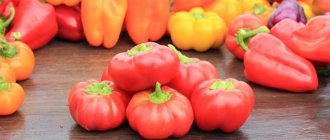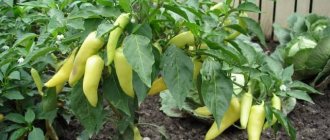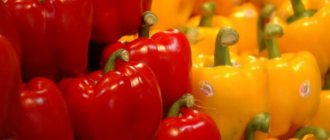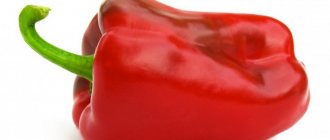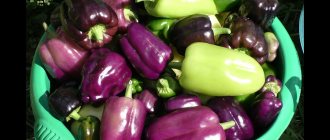Pepper Oriole: variety description, photos, reviews
It is not for nothing that this bell pepper got its name - the ripe fruits of the variety are bright yellow, like the color of the plumage of an oriole.
Other characteristics of the Oriole variety, cultivation characteristics, diseases, pests and main advantages will be discussed below.
The content of the article:
1. History of creation 2. Oriole pepper - description 3. Productivity of the Oriole variety 4. Growing, planting and care 5. Pests and diseases of peppers 6. Advantages and disadvantages 7. Oriole pepper variety - reviews 8. Information from the manufacturer
History of the variety
This pepper was bred by Siberian breeders and was included in the State Register of the country. Oriole pepper is recommended for cultivation in open ground in warm regions of Russia, the Volga region and the Central regions.
Seed material is distributed by agro and some other well-known Russian seed companies.
When growing in the Central regions and the Volga region, it is recommended to first grow seedlings at home, and when weather conditions permit, transplant strong, healthy seedlings to a permanent place in the garden.
Photos of Oriole peppers
Pepper Oriole - characteristics and description of the variety
Oriole pepper is an early ripening variety of this vegetable crop.
– from the moment the sprouts appear until the ripe peppers are harvested, it takes from 2.5 to 3.5 months. This bell pepper is a high yielder with a beautiful rich yellow color when ripe.
The bushes of this variety are standard, low-growing, since the shoots grow in height no more than 70-85 cm. The formation of lateral shoots is average, the plants are semi-spreading, with medium foliage. The foliage is medium in size, slightly wrinkled, the color is soft emerald.
The fruits are heart-shaped, slightly wavy, the skin is smooth and glossy. The stalks are pressed into the fruits, and the tips of the peppers are sharp. The color of peppers at the stage of technical maturity is gently light green; when fully ripe, they are rich yellow with an orange tint, their weight ranges from 70 to 160 g
. The wall thickness is up to 7 mm, the taste is good, there is no bitterness, the sugar content in ripe fruits is quite high. Inside the peppers there are 3 or 4 seed chambers.
HIT!
variety SWALLOW The harvested crop has an excellent presentation and can withstand transportation over long distances without losing its taste and presentation. Ripe fruits are of universal use; they are used for making salads, stuffed, used for preparing hot dishes, frozen and canned.
Pepper Oriole photo on a bush
Experts note that these vegetable plants practically do not react to short-term drops in temperature, forming ovaries even under not very favorable weather conditions.
Pepper Oriole - yield
The yield of the Oriole variety, subject to all rules of agricultural technology and care, is up to 11 kg of ripe peppers per square.
In order for new ovaries to form more actively, it is recommended to collect fruits at the stage of technical ripeness. In this case, the yield can increase.
Siberian prince
The fruits of this variety ripen in 105-115 days. The variety is considered early. The fruits are red in color and weigh on average 180 g. The wall thickness is 5 mm. When unripe, the color of the pods is yellowish. From 1 sq. m of open area, 4-5 kg of fruits are collected.
Standard tomatoes: 8 varieties that will delight you with the taste and abundance of the harvest
Pepper has a bright aroma. The fruits are eaten fresh and used as main dishes and canned vegetables. The variety is recommended for cultivation in the West Siberian region.
“The Siberian Prince” is not afraid of cold, heat, or temperature changes. The variety is considered unpretentious in care and resistant to typical diseases of nightshade crops. The bushes reach a height of 1.5 m; they require staking and shaping. For a good harvest, root and foliar feeding is necessary.
Growing Oriole pepper varieties
Seed material for seedlings is sown in the second ten days of March if summer residents plan to plant seedlings in the future in open ground. For further planting in greenhouses, Oriole pepper seeds are planted for seedlings in the third decade of February. You should also properly fertilize pepper seedlings.
THIS IS INTERESTING!
An article about growing peppers in a greenhouse and open ground.
Seedlings are transplanted to a permanent place at the age of at least 1.5 months, when at least 8-9 permanent leaves have appeared on the plants, and the height of the plants is at least 25 cm. Young plants are transplanted into open ground depending on climatic conditions from the middle of the second ten days to the end of the third ten days of May.
Pepper variety Oriole photo
When planting, plants are buried in the soil up to the first permanent pair of leaves.
The soil for planting this vegetable crop should be light and fertile; loamy soil is best suited. Before planting, humus or compost (at least 1 bucket per square meter) and complex mineral fertilizers are added to the beds.
NEW!
Sweet bell pepper LIVADIA F1
The distance between plants in the rows should be at least 0.4 m, and the row spacing should be up to 0.6 m.
Important!
To prevent Oriole peppers from getting sick and to produce good harvests, you should follow the rules of crop rotation.
Therefore, the best predecessors for bell peppers will be pumpkin plants, legumes and any varieties of cabbage. It is better to plant pepper in one place after 2-3 seasons. In order for the collected pepper fruits to have thick walls, they should be watered regularly, preventing the top layer of soil from drying out. Also, after watering, the soil is loosened so that air can easily pass to the roots, while simultaneously removing weeds. Oriole peppers are fertilized regularly - once every 13-15 days, alternating the application of organic matter and mineral fertilizers.
Growing and care
Seeds for seedlings should be sown in mid-March (optimally from March 10 to March 20). If you plan to plant them in a greenhouse, you can plant them from the end of February.
Adult seedlings (45-50 days old, 20-25 cm high, with 8-9 leaves) are transferred to a permanent place from May 15 to May 30. You need to plant quite deeply - down to the 1st pair of leaves. The optimal planting pattern is 60 x 40 cm. The harvesting period lasts from July 15 to August 20.
It is advisable to grow Oriole peppers in light structured soil (for example, light and medium loams are suitable), additionally seasoned with compost or rotted manure. Good predecessors are pumpkin, greens, legumes and cabbage.
Watering should be regular and timely. It should be performed with warm, settled water from a barrel in the evening. It is important to ensure good air exchange at the roots, so after watering and rain, loosen the soil, while simultaneously weeding it from weeds. Do not forget also about timely fertilizing with mineral and organic fertilizers.
Diseases and pests
Oriole pepper has average resistance to most diseases that affect vegetable plants of the nightshade family. It is weakly affected by pests, most often it can be aphids or spider mites.
Why pepper seedlings suffer:
Diseases and pests of pepper seedlings
It is recommended to treat the above-ground parts of plants with a solution of fungicides for preventive purposes, and the last such treatment should be carried out 2.5-3 weeks before the start of harvesting ripe fruits.
Pests can be controlled using traditional methods - treating the leaf blades with a soap solution or infusion of onion peels.
Advantages of Oriole peppers
The main advantages of the variety include:
- good stable yield;
- compactness of bushes;
- excellent presentation and good taste of ripe fruits;
- the harvested crop tolerates transportation well;
- ripe peppers – large;
- wall thickness - about 5-6 cm;
- bright beautiful color of ripe fruits;
- the harvested crop is well stored in appropriate conditions (about 5 months);
- versatility of using the harvested crop.
There are practically no disadvantages noted in this variety.
Features of yellow fruits
When choosing the best varieties of crops that produce yellow peppers, you need to become a little familiar with the characteristics of such fruits. Despite the fact that it is inferior in taste to red peppers, the vegetable has fleshy pulp filled with phosphorus and potassium. The calorie content of yellow fruits is 27 kcal/100 g of pulp.
The vegetable contains fiber, pectin, and a large amount of essential oil. The pulp is saturated with vitamins vital for humans. First of all, ascorbic acid, known as vitamin C, helps strengthen the immune system and fight the human body against colds. Vitamin B helps calm the nervous system and strengthens bone tissue. Vitamin PP is very important for people suffering from diabetes, as it lowers blood sugar levels and strengthens blood vessels. You should also add vitamins A, E, iron, calcium and other useful microelements to this list.
Important! In terms of its beneficial composition and content of the “happiness hormone,” yellow pepper can compete with dark chocolate. But unlike a sweet treat, the low calorie content of the fruit pulp does not add extra weight.
The yellow fruits of bell peppers have gained wide popularity in the preparation of various dishes, as well as winter preparations. The vegetable looks beautiful in canned food, various salads, stuffed or simply grilled.
Pepper Oriole - reviews from those who planted
Below are some of the reviews about the Oriole pepper from those vegetable growers who have already grown it in their garden beds:
Nastya, 44 years old:
I grow peppers in my garden every season. Last year I decided to plant the Oriole variety of bell pepper. The bushes of this variety are compact, so about 4-5 plants fit on one square. Caring for peppers of this variety was easy, because the bushes did not need to be formed and tied up, the plants did not get sick, and they bloomed actively. As a result, from one square I collected about 10 kg of fruits of varying degrees of ripeness.
Video about the Oriole variety
Katerina, 46 years old:
When buying vegetable seeds in the spring, I noticed the Oriole pepper, attracted by the bright yellow color of the ripe fruits of the variety and the promise of high yield. Therefore, this season I planted seedlings of this vegetable plant. Seed germination is about 85%. She took good care of the seedlings, so the plants grew strong and strong. I collected the first ripe fruits approximately 1.5 months after transplanting the seedlings into open ground. The harvested crop was used for stuffing, and also prepared for the winter: lecho, frozen in the freezer.
Olga, 39 years old:
The main characteristics of the Oriole pepper generally correspond to those presented in the description of the variety. True, the first fruits were collected approximately 3 months after emergence, but with regular watering and fertilizing, the fruits grew large with thick walls. And the taste of the fruit is beyond praise.
If vegetable growers are going to plant some other varieties of peppers in the new season, they should pay attention to the early-ripening Oriole pepper - a variety with a good yield indicator that bears fruit well even with temporary drops in temperature.
Reviews
Anna Petrovna We were attracted to early varieties because they produce a harvest very quickly. I mainly grow Aladdin and Claudio, but I am not against new experiments.
Vladimir For me, the speed of ripening of peppers is not important, since I plant vegetables for myself, and not for sale. I prefer spicy varieties.
Margarita Aleksandrovna I am always looking for new varieties for myself, as I like to experiment. I was very interested in the Cardinal variety, although I don’t understand why it was called that. If I'm not mistaken, the cardinal has a red robe, and the bishop has a purple robe.

